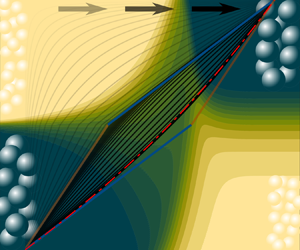Published online by Cambridge University Press: 25 March 2024

The feedback between particle-size segregation and rheology in bidisperse granular flows is studied using the Stokes’ problem configuration. A method of lines scheme is implemented to solve the coupled momentum and segregation equations for a normally graded particle size distributed bulk at constant solids volume fraction. The velocity profiles develop quickly into a transient state, decoupled from segregation yet determined by the particle size. From this transient state, the velocity profile changes due to the particles’ relative movement, which redistributes the frictional response, hence its rheology. Additionally, the particles’ relative friction is modified via a frictional coefficient ratio, by analogy with the particles’ size ratio. While positive values of this coefficient exacerbate the nonlinearity of the velocity profiles induced by size differences, negative values dampen this behaviour. The numerical solutions reproduce well the analytical solutions for the velocity profile, which can be obtained from the steady-state conditions of the momentum and segregation equations for the transient and steady states, respectively. Segregation–momentum balances and four characteristic time scales can be established to propose two non-dimensional quantities, including specific Schmidt and Péclet numbers that describe broadly the segregation–rheology feedback. The proposed scheme, theoretical solutions and non-dimensional numbers offer a combined approach to understand segregation and flow dynamics within a granular bulk, extensible across many flow configurations.